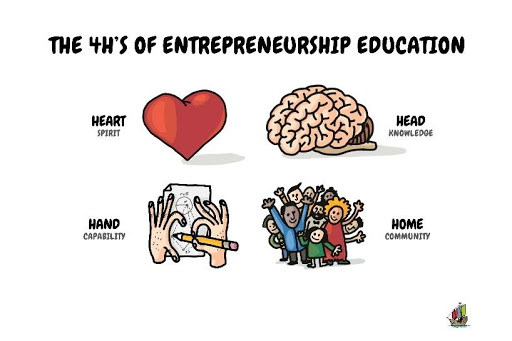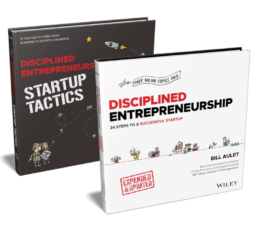Republished from Elgar Online
I have had the great honor and fortune to teach entrepreneurship for over a decade at MIT, and it has been a journey of continuous learning and improvement. While I could write books on what I have learned about how to teach entrepreneurship, here is a selection of 13 key lessons learned that I encourage you to consider incorporating into your teaching strategies.
- Define your terms. I’m an engineer by training, so I was taught that the first rule before solving a problem is to define your terms. This is excellent advice here as well. What do we mean by entrepreneurship? What is the difference between SME (Small & Medium Enterprise) and IDE (Innovation-Driven Enterprise) entrepreneurship? What is innovation? What’s the difference between entrepreneurship and innovation, and why does that matter? These differences matter and too many people treat entrepreneurship as a catch-all term or as a single-minded focus on billion-dollar ‘unicorn’ startups. The problem is that if you don’t define entrepreneurship, you can’t define your learning, and hence, your teaching objectives. Hint: At MIT, we believe entrepreneurship is about more than just startups.
- Understand your mission and don’t get distracted. Beyond the individuals who alone or with others are engaged in driving entrepreneurship, there are three major groups play a key role:
- Economic development organizations (e.g., publicly funded regional development initiatives);
- Investment organizations (e.g., venture capital and angel investor groups); and
- Academic institutions (e.g., colleges, universities, and academic centers). Each is important and has different objectives. Economic development organizations have the goal to produce a large number of companies. Investment organizations’ success metric is ownership percentage in companies that grow to become valuable companies and provide a very attractive return on investment. Academic institutions should be focused on creating entrepreneurs by educating them on how to succeed in entrepreneurship. Blurring the lines between these three categories is very tempting and easy to do but in the long term, it is extremely destructive. In particular, by having academic institutions take on the roles of creating companies or investing in companies, makes academic entrepreneurship education dramatically less effective. Incentives almost immediately are at cross purposes and the students figure this out quickly. Do the students look at us as educators who are there for their personal development or are we investors who have a vested interest in a positive outcome? Should they be open and honest with us or should they try to impress us so they get us as investors? What happens to those we do not invest in, what signal does that send to the broader market? The moment we are something other than 100% educators is the day we lose our “honest broker” uniqueness relative to the first two organizations. Being an honest broker educator to me means that we are always completely looking out for our students’ best interests. Measuring our success by the number of companies we prod our students to start is not the right metric. We should determine what constitutes success in entrepreneurship education, and then assess our success in teaching those elements. Vanity metrics like companies started, money raised by companies, jobs created, awards won and the like can distract us from our unique mission.
- Entrepreneurship can be learned. Historically, there has been a widespread perception that entrepreneurship success is nature rather than nurture. In fact, I believed this when I first started teaching. My friend and mentor, MIT Professor Ed Roberts, showed me data that demonstrates the more times a person engages in an entrepreneurship venture, the more likely they are to be successful. As I thought about this, it became more obvious that this is true. Having been a serial entrepreneur, I knew much more the second time around than the first and even more the third time, because I learned so much each time I went through the process. We get better over time in most things in life, so why should entrepreneurship be different? It isn’t. The data do not lie. The question then becomes, can we teach it? As my other lessons demonstrate, I believe that we can.
- Entrepreneurship is a craft. A breakthrough for me was properly framing entrepreneurship. Part of the frustration that people have in thinking about entrepreneurship education is that they want the field to be a “science” i.e., deterministic. That is, if we do A and B and C, we will get outcome D. That is not how entrepreneurship works. If we do A, B and C, our odds of getting outcome D increases significantly, but the outcome is not assured. This frustrates all of us and makes our problem much harder, but it is the reality. This does not mean entrepreneurship is an “art” that is abstract and success comes only to a gifted few.
- Entrepreneurship is a “craft” which means it is accessible (something that everyone can do) and yet it produces unique products. It is also learnable because there are fundamental concepts that increase your odds of success. Like a craft, it should be taught in an apprenticeship model where the theory (fundamental concepts) is applied through practical application to convert knowledge into capability. This mental model helps educators and students understand what to expect on their entrepreneurship education journey.

- Entrepreneurship is not a spectator sport. A clear derivative of the statement above is that our entrepreneurship education offerings should be focused more on doing than leaning back, listening, and reflecting. Hands-on work and achieving results is one of the key tenets of an entrepreneur.
- Entrepreneurship is a team sport. Research by numerous academics like Professor Roberts and USC Professor Noam Wasserman has shown that the odds of success are materially higher if you have a team of founders than if you have an individual founder. People focus way too much on having a “brilliant” idea but pay much less attention to the strength of their founding team. That’s why a big part of our teaching methods involve having students work in teams on their projects so that they learn how to do so effectively. They must also learn how to make tough decisions to add and remove members from their team.

- Spirit of a pirate. Entrepreneurship is all about doing something that has never been done or in a way that has not been done before, so entrepreneurs have to be willing to be different and venture into new areas. If all the fish are swimming one way, entrepreneurs must not only be willing to swim in the other direction, they should also enjoy swimming in the other direction. For an entrepreneur, it all starts with the first of our four H’s – Heart. The “spirit of a pirate” includes not just a willingness to be different, but also an understanding of the difficult journey ahead, as well as the belief that success is still possible at the end of this journey — and that it is well worth the effort. In the Martin Trust Center for MIT Entrepreneurship, we live up to the Steve Jobs quote, “It is more fun to be a pirate than to join the navy,” and we even incorporate the spirit of the pirate into our center’s logo!

- Implementation skills of a Navy Seal. Once our students understand entrepreneurship and are excited and confident about it, we cannot send them into battle without proper training. That is the essence of our next two H’s, the Head and the Hands. We must teach our students the first principles and knowledge that will optimize their chances of success — this is the “Head.” Some of those principles (consolidated from many sources) are documented in the Disciplined Entrepreneurship books I have written and we use in our classroom. We then must create projects where students learn by doing, allowing them to translate their knowledge into capability — the “Hands.” This combination of theory and practice is essential because it reinforces and deepens both the theory and the practice. This creates excellence in execution skills that are required to do something that has never been done before with minimal resources.
- Entrepreneurship education is in its infancy. We have to recognize that entrepreneurship education is relatively new compared to other disciplines such as law and medicine, as well as other business areas such as finance, accounting, strategy, and organizational design. As a result, there is not a large, mature, rigorously curated body of knowledge in the field and our knowledge is rapidly evolving. This has created a situation where demand far outstrips the supply of rigorous, high-quality entrepreneurship education. We must avoid filling this gap with less than rigorous “storytelling,” which at times assumes that assembling successful entrepreneurs in front of students so that they can spout platitudes about working hard is sufficient to prepare them for the great challenges of entrepreneurship. Storytelling has a role in fostering spirit within potential entrepreneurs but is not a substitute for teaching rigorous fundamentals. It is also critically important that in such a dynamic evolving field, we as educators stay current with the latest developments.
- Systems thinking is essential. I cringe when I hear simple solutions to entrepreneurship. Entrepreneurship is a complicated multi-faceted challenge which requires a systems thinking approach rather than a linear mindset. We have to constantly look for connections and relationship between the different parts of the system. We also have to understand that there will most likely be a time delay between an action and the full effects of that action. This is daunting when teaching because it makes it difficult to assess the success of any one program. Systems thinking is the only way to create high-quality entrepreneurs we need for the future.
- An open system with a common language is the best way to scale. The collective wisdom of the group is always greater than that of any one individual. Entrepreneurship knowledge will not come from any one person, institution or country. We all have to work together to build a body of knowledge that everyone can contribute to if we really want to create a discipline that is respected by academics, practitioners, and students. We frame our educational approach using the metaphor of a toolbox, and we constantly incorporate tools from many sources if they are appropriate for our students. The new tools are curated and integrated with the existing ones. When new concepts are proven worthy, we can easily incorporate them without throwing out all the previous good work we have done. Instead, we build off what has come before and continually improve each tool and the overall toolbox, and then we share the toolbox with the rest of the entrepreneurship community through books and articles, workshops, and many other ways.
- The 4th H — “Home” — is most often overlooked. The role of community is most often overlooked and not yet well codified into our educational efforts. This is the fourth and final “H” which stands for Home, or the ability to build and be a productive member of vibrant and sustainable communities. The godfather of entrepreneurship studies at Harvard Business School, Professor Howard Stevenson, famously defined entrepreneurship as “the pursuit of opportunity beyond resources controlled” — the key point being entrepreneurs have to be able to creatively marshal resources they do not currently control, including knowledge, networks, and emotional support. Entrepreneurs do not have the luxury of big companies that have considerable resources under one roof. Entrepreneurs have to be efficient and embrace decentralization. They need to have a core set of skills, but build community with other entrepreneurs and partners both to ensure the success of their individual companies, and of the community of entrepreneurs as a whole. Anyone who has worked with me knows my favorite quote, from Rudyard Kipling’s The Jungle Book: “For the strength of the pack is the wolf, and the strength of the wolf is the pack.” Each entrepreneur has to be strong in their own right, but the “pack” makes them so much stronger and they can achieve so much more.

- Have fun when teaching. This point might seem trite, but having a sense of self-deprecating humor and humility is important for entrepreneurs. While entrepreneurs must take the job of creating a business very seriously (it is hard and important work), they can’t take themselves too seriously. Failure is part of the entrepreneurship process and if they take themselves too seriously, not only will they not survive, but their organization won’t either. As instructors, we teach by our actions at least as much as with our words. So when teaching, let’s not take ourselves too seriously, but let us take our responsibility of teaching very, very seriously. Enjoy the good times and teach our students how to celebrate them as a team, because there are always lots of bumps in the road on the entrepreneurial journey, and we all need to keep our spirits up to survive and thrive.
The author
Bill Aulet
A longtime successful entrepreneur, Bill is the Managing Director of the Martin Trust Center for MIT Entrepreneurship and Professor of the Practice at the MIT Sloan School of Management. He is changing the way entrepreneurship is understood, taught, and practiced around the world.

The Disciplined Entrepreneurship Toolbox
Stay ahead by using the 24 steps together with your team, mentors, and investors.
The books
This methodology with 24 steps and 15 tactics was created at MIT to help you translate your technology or idea into innovative new products. The books were designed for first-time and repeat entrepreneurs so that they can build great ventures.

How relevant was this article to you?
Click on a star to rate it!
Average rating 4.9 / 5. Vote count: 7
No votes so far! Be the first to rate this post.
We are sorry that this article was not useful for you!
Let us improve this post!
Tell us how we can improve this post?

I think this is a good summary of our philosophy on how to teach entrepreneurship. When asked to do it, I tried to avoid doing it, but in the end I am very glad I did and happy with the result.